 Tech giant Intel, Oregon’s largest private employer, faces new challenges in its never-ending race to stay ahead of the pack.
Tech giant Intel, Oregon’s largest private employer, faces new challenges in its never-ending race to stay ahead of the pack.
Tech giant Intel, Oregon’s largest private employer, faces new challenges in its never-ending race to stay ahead of the pack.
STORY BY BEN JACKLET // PHOTOS BY ANTHONY PIDGEON
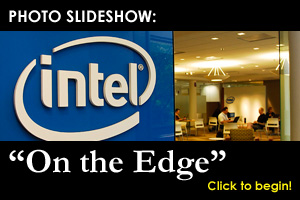 |
 |
Intel Oregon’s Ajay Bhatt |
Ajay Bhatt’s expertise as a chief client architect and research fellow for Intel Oregon is so deeply technical that it would be difficult to explain in plain English what he has accomplished — were it not for three simple letters:
USB.
Bhatt was struggling with multimedia applications at his home computer one night in 1991 when he decided there had to be a better way. “At that time, you had to open up the PC, add a card, set a whole bunch of switches, run some programs, and see if you could get a sound out of the machine,” he recalls. “And if it didn’t work you would fiddle with the switches again, restart it and try again. And I was just thinking, why is it this way? What would happen if it was just like an electric outlet, where you plug things in and turn on a switch and things just work?”
That’s what Bhatt and his team eventually accomplished. USB became an immediate game changer that enabled all sorts of innovations from all sorts of companies, and the technology has improved exponentially with each revision. The second version was 40 times faster than the first, and the recently completed USB3 will be more than 10 times faster than that once it starts trickling into the market later this year.
Having smashed down that barrier, Bhatt is now targeting others from his Beaverton cubicle. His latest objective is a laptop that lasts all day on a single battery charge. Sounds simple, but nobody’s managed it yet. And when it arrives, innovations, profits and jobs will likely follow.
Bhatt, or rather a Bollywood actor playing Bhatt, stars in a hilarious, over-the-top Intel commercial that casts the company’s nerdy technologists as swoon-inducing rock star hunks. It’s all great fun, but it is also part of a serious “Sponsors of Tomorrow” campaign by the world’s top maker of computer chips to reassert itself as the lead dog in an increasingly competitive and fragmented business landscape. The $38 billion technology giant that employs 15,300 people in Oregon with an average salary of $113,000 has defined itself through its innovations for 40 years. But this is no time to become complacent. If Intel hopes to return to the awesome growth of its glory years, it will need to expand into new markets where it barely has a toehold, much less a near monopoly. Intel microprocessors may power the vast majority of the world’s supercomputers, servers, PCs and Macs, but they do not power the iPod, the iPhone, the BlackBerry or the Kindle. This is huge. Even Intel CEO Paul Otellini has to admit, as he did publicly earlier this year, that “the old, boring beige desktop that we all grew up with is about dead.”
That stark pronouncement helps explain why, even while backing away from outdated manufacturing facilities amid a faltering economy, Intel continues to invest optimistically in Oregon, recruiting scientists, engineers and developers from around the globe to join a multi-faceted brain trust that thrives on constructive confrontation and the anti-hierarchical principle that the best science wins.
The mind-boggling advances that have become commonplace at Intel are often broadly attributed to Moore’s law, the principle named after Intel co-founder Gordon Moore that guarantees exponential performance improvements as engineers manage to cram ever-more, ever-smaller transistors into integrated circuits. But while that explanation is technically accurate in many instances, it omits the vital human factor: the creativity and drive of the people who make these things happen.
Consider Bhatt’s story. Born and raised in India in an era of limited opportunity there, he came to the United States on a specific mission to study with and learn from a professor whose research had caught his fancy. He read all of the professor’s work, contacted him repeatedly and eventually earned a position in his idol’s lab, earning $200 a month at City University in New York, developing technology that would help power the Columbia Space Shuttle.
“I didn’t even care about the money,” he says. “I just wanted association with the professor. I just wanted to learn and soak all the knowledge in.”
Before he was able to complete his PhD, Bhatt was recruited into the private sector, first by Wang Laboratories and later by Intel, where he has worked on PCI Express and Accelerated Graphics Port as well as USB, earning nine patents for his discoveries. He moved to Oregon in 1996. In 2005 he became an Intel Fellow, a role reserved for the company’s top innovators, to pass along lessons learned and mentor promising colleagues.
It is worth pointing out that one of the key moments in the development of USB involved insubordination. Bhatt worked closely with a senior Intel fellow who disagreed with some of the architecture Bhatt and his colleagues were building. “I would go to him and he would say, you know, this doesn’t make sense,” says Bhatt. “And then I came back with the data and sat down with him, and this very senior, very well-respected technologist said, ‘You know, you were right, I was wrong. You have proven me wrong.’”
The message to Bhatt was an encouraging one on several levels: “In a lot of other companies, it’s the hierarchy that rules,” he says. “That doesn’t exist here. Anybody who has a good idea can come and challenge you. It is all data-driven. That exchange, that open environment, really works.”
It’s also exactly the sort of environment he enjoys as a scientist. An important part of Bhatt’s job as mentor involves encouraging challenges from upstarts within Intel’s mobile platforms group as they race to build the next great game-changer. Which brings him back to the elusive all-day laptop battery charge. “None of the things I’ve done were easy when I started them,” he says. “I like to pick up projects where nobody gives you a chance to succeed. Those are the best ones.”
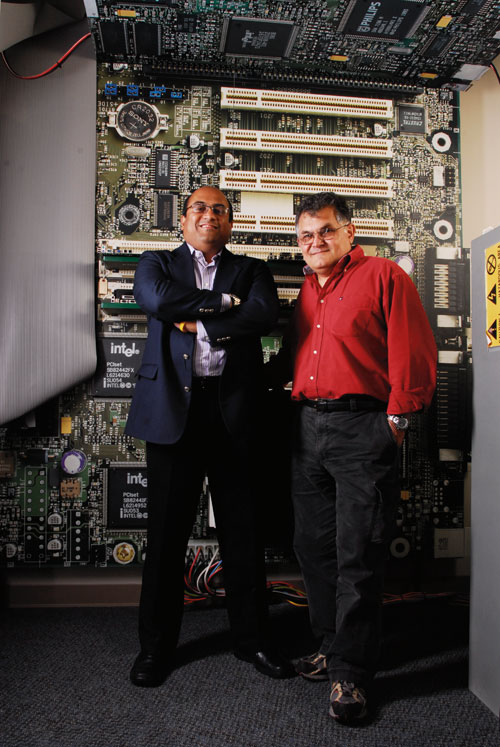 |
Anand Pashupathy (left) and Mojtaba Mirashrafi developed an idea for an anti-theft service for laptops into a shipped product in just 12 months. |
Mojtaba Mirashrafi shares Bhatt’s passion for making complex things work simply. Born in Tehran, Mirashrafi came to Oregon State University to study computer science, and by 1985 he had gotten a job offer he couldn’t refuse, building mission control equipment for nuclear reactor shutdown procedures and offshore oil platforms.
Before long he was scooped up by Intel, where he worked on supercomputers, videoconferencing and, in the mid 1990s, voice-over IP (early versions of today’s Skype). At that time Intel was backing a lot of spin-offs, so Mirashrafi left the mothership in 1996 and caught the start-up bug, building a voice-over IP enterprise called Effusion and three other companies before returning to Intel in 2006 to work with a colleague from his videoconferencing days named Anand Pashupathy.
Pashupathy, an Indian immigrant with advanced degrees in computer science and business, was interested in building a new anti-theft service that automatically disables computers once they are stolen to protect their data. He worked on the business plan, while Mirashrafi, who holds 15 patents, fine-tuned the technical details. Not only did he and Mirashrafi sell the idea to their managers, they managed to win permission to function as a startup within Intel, with their VP serving as VC.
“Once we had [our supervisor] convinced and once we got the money, he said, ‘Only come back to me if you screw up something or you have a big deal that you need my approval on,’” says Pashupathy. ““All the small stuff, don’t come to me.’”
That enviable level of freedom brought quick results. “We took it from an initial idea to a shipped product in about 12 months, which is unheard of at Intel,” says Pashupathy.
Mirashrafi attributes that quick progress to Intel’s willingness to nurture “the spirit of the hungry startup.” And he sounds more like a serial entrepreneur than an engineer as he describes the road ahead: “If we can replicate this we’ll keep a small agile team. Two years from now our team will be different. We’ll have to integrate it with the big machine in order to scale. But just learning how to start it small, get the concept, get the momentum, and then hand it off to the rest of the big Intel team to deploy it worldwide, and then to go start a different one and keep the pipeline going.”
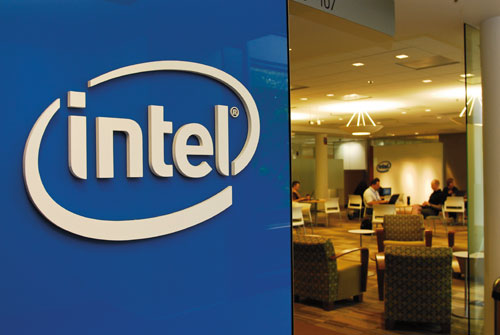 |
BY THE NUMBERS$37.6 billion |
Another key, of course, is the quality of the team itself, and its chemistry. Pashupathy and Mirashrafi clearly enjoy working together, and they make a compelling, if somewhat odd, couple, with Pashupathy playing the smooth pitchman honed in on sales and markets while Mirashrafi cultivates the role of the rumpled genius whose real interest lies in solving extremely elaborate puzzles. They joke with each other often as they describe their project, but they also show a great deal of pride in their results.
“Everybody on the team saw this as an opportunity for change and decided to make it happen,” says Pashupathy. “We were trying to do something different for Intel, and to change, in a very small way, how Intel will make money.”
There are small ways to change how Intel makes money, and there are much, much larger ways. One of the biggest changes under way at Intel in Oregon involves open source software. Intel has recruited and hired some of the best minds in open source, including Keith Packard, Marcel Holtmann and Alan Cox. It has become the second-largest contributor to the open source Linux software code. And it recently invested $884 million to buy Wind River Systems, a California software company that has developed the world’s most widely used operating system for devices such as navigation systems, appliances and robots. Not long after announcing that purchase, Intel said it had formed a partnership with Nokia, the largest manufacturer of cell phones in the world.
During the great Age of Exuberance, Intel dominated hardware with the same ruthlessness with which Microsoft dominated software. That dynamic has changed dramatically with the powerful rise of Google, Apple, ARM, Qualcomm, Amazon and Research in Motion, which have executed a devastating end run around Microsoft’s would-be monopoly on software and threaten similar damage to Intel. Intel’s foray into open-source software is no idealistic experiment; it is both a hedge and a vital move toward diversification, not to mention an offering customers are demanding. Behind the investments and partnerships is an Oregon-centered R&D race that is inherently different from other Intel pursuits because open source is, well, open, and Intel has never been known for its openness, as evidenced by the title of legendary Intel CEO Andy Grove’s 1999 book, Only the Paranoid Survive.
At the heart of Intel’s open source play is Moblin, an operating system for smaller devices: netbooks first, with a future eye on smartphones. Intel is backing Moblin’s development, but it does not own it. In fact, Intel has opened the process of building the system to anyone who wishes to participate, by transferring it over to the Linux Foundation. That’s hardly a move one would expect from a company that was recently fined $1.45 billion by the European Union for monopolistic practices. But Imad Sousou, a Jordanian-born developer who has been working on open source at Intel in Oregon for 15 years, says moving Moblin over to the Linux Foundation has brought stronger participation and better results.
Sousou’s interest in open source isn’t just professional. He is a true believer who makes the case that the Intel ideal of a technical meritocracy liberated from politics and position is best served through open collaboration. Moblin represents Intel’s biggest foray into that model, and Sousou says the operating system is off to a good start that will only improve with further revision. “What we’ve done is create an animation framework,” Sousou says. “In essence the software developer, instead of being a coder, becomes the director of a movie. It’s closer to video games. Moblin enables you to do this really advanced user experience with 3D animation on a very small device.”
When most consumers think of really advanced user experience on a very small device, the word that generally comes to mind is iPhone. Sousou, who began his career as a Mac programmer, clearly respects what Apple has accomplished, even though the iPhone is not powered by an Intel processor. At least not yet. Intel has missed out on the smartphone boom while other, smaller companies have thrived. That is expected to change in 2011, when Intel plans to enter the market with a chip for handheld devices.
“Over time Apple will probably move over to the better hardware,” he predicts, “and that will definitely be the Intel platform, as Intel moves over towards smartphones and small devices.”
That would be huge.
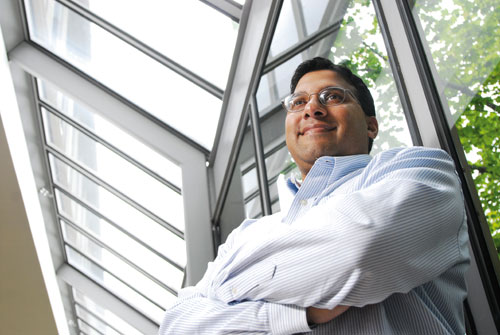 |
Ronak Singhal is focused on the next version of the Intel Xeon processor, due out in 2013. |
Not all of the research going on at Intel Oregon represents forays into new areas. There is also the perpetual race to make the next great microprocessor that is more powerful and complex than anything that has come before. That’s the quest that occupies Ronak Singhal, senior principal engineer of the team that created the Intel Xeon 5500 series. Xeon is the brain inside 80% of the world’s fastest supercomputers, powering everything from server farms to research institutions, and few if any people know more about the contents of these brains than the 34-year-old Singhal, a Carnegie Mellon grad who has spent his entire career at Intel Oregon and already earned four patents for his innovations.
When Singhal describes the new Xeon as “the fastest processor on the planet,” he isn’t boasting so much as stating a fact. He speaks quickly and with that sort of crystalline precision you would expect from someone whose life work revolves around maximizing performance and efficiency in an industry with ridiculously high standards in those areas. With the release of Xeon 5500, Singhal and his team have already begun looking forward to the next version that will set the new standard, due to be released in 2013.
But how long can these chips keep getting faster, smarter and cheaper? Isn’t there an endpoint out there somewhere for Intel? Singhal doubts it. He expresses full confidence that, contrary to the suggestions from critics that the innovations cannot possibly continue, they will. “Every few years someone says, ‘You’re running out of steam, you’re going to fall off this curve. You can’t keep generating these gains and improving your power and performance while making it cheaper to the consumer. At some point the laws of physics are going to catch up to you.’ But Intel always finds a way.”
It would be quite a challenge to create a research position further from Singhal’s never-ending quest for the ultimate computer brain than Genevieve Bell’s job as an Intel anthropologist. At first glance it seems impossible that the two people could work for the same company.
Bell’s research is as free ranging as Singhal’s is narrowly focused, and her unapologetic style and overstated personality contrast sharply with Singhal’s precision. Whereas Singhal takes all of 30 seconds to describe his upbringing, education and hiring at Intel, Bell launches into a richly detailed narrative that leads the listener from the outback of Australia to the bar in Silicon Valley where a wacky entrepreneur decided on the spot that the tech world needs more anthropologists.
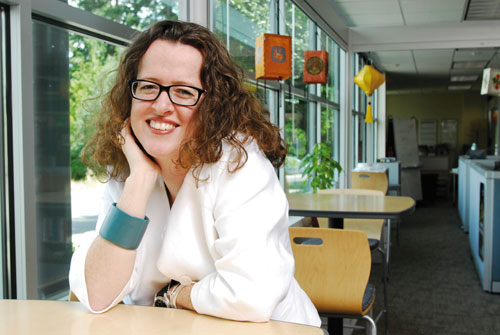 |
Intel anthropologist Genevieve Bell focuses on the big questions in her research, especially the question of what comes next. |
Daughter of one of Australia’s most prominent anthropologists, Bell has spent much of her life serving as an outsider looking in, gaining trust, immersing herself into a culture, participating in it and distilling her findings into generalized truths. She learned under her mother’s tutelage in the outback, honed her skills on the Indian reservations of the United States and the campus of Stanford University, and ended up working for Intel Oregon through a quirk of fate that only could have been possible in the silicon boom years of the mid-1990s. She has been with the company for 11 years, conducting field research with a team of social scientists who attempt to anticipate the market by investigating who is using technology, how, where and to what purpose. They were conducting field research in India and China in 1998, and Bell recalls thinking, “If this takes off, it is going to be very big and very different.” It has. In 1998, 65% of the people online were Americans. By 2008 that share had plummeted to 16%.
“When you look at Intel’s original single-page business plan from 1968,” she says, “there’s this wonderful line that says, ‘We anticipate that much of our market share could come from outside of California.’ Well, what does the future of the Internet look like when only 16% of the users are Americans?”
That’s the sort of wide-angle question Bell has built her career on answering. “Our point has always been that people matter,” she says. “Moore’s law is great. Smaller, faster, cheaper, absolutely, but what Moore’s law doesn’t tell you is what happens next. For my colleagues and me, that was always what was interesting: What happens next? And can you reverse engineer it? What is it that people value? What motivates us? What do we care about? What are we passionate about? Can you take the things that people care about now and use that as the starting point for new technologies?”
Good questions. And she has more. “Now that the Internet is on phones and GPS devices, what does that mean? How does that change things? And a corollary to that is the tension between devices that function best when they are constantly connected and human beings who function best when they are periodically disconnected. How do we start talking about technology in ways that won’t consume people’s entire lives?”
What does all this have to do with a company that manufactures computer chips?
Wait 20 years to find out. Bell’s research won’t produce the next great game changer in the tradition of USB, or the next amazing chip that disproves the skeptics by setting new standards for performance, or the operating system that enables Intel to sprint from nowhere into the lead in the arms race for the perfect hand-held computing device, or the innovative new service that rewards Intel for internally seeding hungry start-ups.
Rather, her job is to tie these and other efforts together and make sense of what they mean, the human needs these innovations help us to fulfill, the needs that remain unfulfilled, the lingering problems that technology may help us to solve one day.
When you think about it in those terms, it’s easy to conclude that Intel’s most inventive technologists aren’t really like rock stars at all. They’re way, way cooler.



